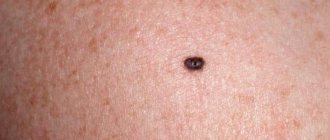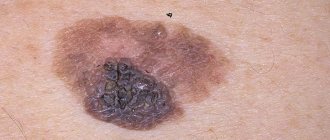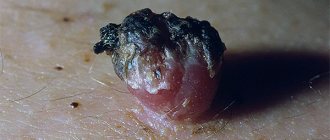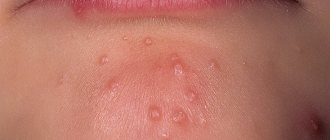Every Tuesday, AiF Health explains what signs may indicate that it’s time for you to see a doctor. This week we tell you why moles are dangerous, how to notice the first signs of a mole degenerating into a malignant skin tumor, and which specialist to turn to for help.
Many people do not pay attention to this “rebirth” and think that their body is still just a harmless spot. Meanwhile, early diagnosis helps defeat the disease.
What is a nevus?
A mole is a consequence of the excessive work of melanocytes (cells that produce melanin), the accumulation of the pigment they produce. The more melanin spots in the cells, the darker the nevus will be. A person can have these marks from birth. Sometimes they appear throughout life - mostly before the age of 16.
The mole has darkened. Don't be scared right away. This is a normal process if it is associated with the development of a formation - a newly appeared mole. It is “born” as a light spot, which darkens over time, approaching its permanent shade. However, we note that the period of development is always gradual and consistent.
Signs of a safe mole
The nevi themselves are safe for the life and health of the owner of the mark. Signs of a normal mole:
- No more than 6 mm in diameter.
- Static in size - does not grow.
- Has smooth (not sharp) edges.
- Smooth surface.
- There are no roughness or growths.
- Static in color.
If black dots appear inside the nevus, which increase in size and go beyond its boundaries, then this may be one of the signs of melanoma. What is this? A malignant formation of the skin, which can lead to serious consequences for human health, like any cancerous tumor. The transformation of a harmless nevus into melanoma is called malignancy. A number of factors can provoke this.
Thus, if a mole has darkened, then this is a reason to pay attention to the nevus. But this will not be a defining sign of the development of melanoma.
Associated symptoms
Convex, hanging growths are equally susceptible to degeneration; hanging ones are often injured. The process of rebirth is accompanied by symptoms:
- Severe itching appears in the center of the mole and the area around it. Itches due to degeneration, due to the influence of external factors: insect bites, irritation from chemicals, food. When injured, the nevus can become inflamed and bleed.
- The hanging mole turns black, the old papilloma dries out and falls off. Dry old growths fall off on their own, leaving a pink mark, and a lump or new formation may appear. They dry out due to poor circulation and poor nutrition. The fallen piece should be taken for analysis to identify malignancy.
- It begins to peel off and become covered with a crust that can peel off.
- The flat growth begins to grow, change shape and structure.
- Pain appears.
- The growth or birthmark becomes hard to the touch.
- An inflammatory process accompanied by the appearance of small ulcers that emit an unpleasant odor and heal poorly.
- The skin around the formation swells, darkens or lightens, and redness appears.
Symptoms cause the development of a cancerous tumor.
Why did the mole darken?
Changes in nevi lie in the action of certain factors on them. Can a mole darken? Yes, and it’s all about the reasons that affect the activity of melanocytes (and, accordingly, the amount of pigment they produce). This is the following:
- UV rays. Ultraviolet light most contributes to the accumulation of melanin in cells. That's why we get a chocolate tan under the rays of the sun and solarium lamps. If you periodically spend a long time in the sun, you may notice that the mole has darkened along with the skin (sometimes the nevus becomes almost black, black spots appear on it). Experts advise protecting marks from direct exposure to UV rays - using protective equipment, covering yourself with clothes, and not sunbathing in the sun from 11 a.m. to 4 p.m. If you have a lot of moles on your body, then it is better to avoid going to the solarium.
- Changes in hormonal levels. This condition also affects the production of melanin. Therefore, nevi can darken during adolescence, pregnancy and menopause in women. The darkening of nevi is one of the external signals that the body is being rebuilt and there is an imbalance in its systems.
- Damage. A mole may well change its color due to mechanical impact on it or injury. The cause could even be constant friction against clothing.
Scientists' opinion
The most common malignant skin tumors are basal cell and squamous cell carcinoma. Everything has been clear with them for a long time: it has been proven that the likelihood of these tumors occurring is increased in those places where there are scars from severe burns and chronic inflammatory processes. Trauma contributes to the development of skin cancer and is one of the recognized risk factors. However, it is important to understand that although the risks are increasing, they are still very low. If you severely scald your hand with boiling water and you have scars, this does not mean that years later you will definitely develop a malignant tumor.
In the case of melanoma, there is no such clear evidence. Several studies have been conducted in the last century. Some of them describe cases where melanoma arose after injury to a mole or even “clean” skin. No other scientific work has found such a connection. Scientists are generally not inclined to make hasty conclusions; they are guided by the principle of post hoc ergo propter hoc - “after does not mean as a result.” If after a skin injury, either single or repeated, melanoma soon appears in that same place, this does not mean at all that the first entailed the second. There are also alternative explanations:
- Perhaps there was already a malignant tumor, and the injury simply forced him to pay attention to it.
- It is possible that the injury accelerated the growth of a pre-existing malignant tumor.
Let's consider another possible situation. A patient comes to a doctor to have a mole removed, and the doctor grants his wish. After some time, the mole grows back, it is removed again, and a biopsy shows that it is melanoma. Did the first operation provoke malignancy? It is impossible to give a definite answer to this question. Perhaps the patient originally had melanoma, and the first time it was not completely removed. Perhaps malignancy occurred later, and the operation had nothing to do with it.
In 2000, scientists from the University of Ulm (Germany) conducted a survey among 369 patients who were diagnosed with melanoma. 337 study participants said that no trauma preceded the appearance of a malignant tumor. 22 participants reported that they had previously experienced a single skin injury at the site of the malignancy, and 10 participants reported chronic skin injury. After conducting an analysis, the authors of the work came to the conclusion that, apparently, neither acute nor chronic skin injuries should be considered as causative factors in the development of melanoma.
In 2002, scientists from the National Cancer Center in Sofia (Bulgaria) conducted a case-control study, during which they surveyed 156 patients with melanoma and 156 healthy people. The authors concluded that trauma to benign pigmented lesions is associated with a slightly increased risk of melanoma, but this association was not statistically significant.
Of particular interest to scientists is the connection between injuries and the development of subungual melanomas, which occur under the nail plate. In this case, the role of the main risk factor for the development of melanoma, ultraviolet radiation, is not so high. Many scientists doubt that UV rays can penetrate the nail plates strongly enough to damage the DNA of the skin and lead to malignancy. In 2002, doctors from the Department of Dermatology at the University of Tübingen (Germany) decided to evaluate the role of mechanical injuries and analyzed data from 732 patients. Many patients noted that the development of the tumor was preceded by trauma to the fingers or toes, however, it was not possible to assess whether there was a real connection. The authors of the work suggest that trauma forces attention to melanoma or somehow contributes to its growth. It should be noted that subungual melanoma is generally quite difficult to diagnose; doctors often detect them in the later stages. Injuries to fingers and toes are by no means uncommon, especially among people who engage in physical labor or sports. At the same time, subungual melanoma is rare; in Europeans it accounts for 2–3% of all cutaneous melanomas.
There are still more questions than answers. One way or another, there is not a single case known in which it was possible to prove an unambiguous cause-and-effect relationship between skin damage and the development of melanoma. But such a connection cannot be completely ruled out.
What is a hanging nevus?
Let’s look separately at why the hanging mole has darkened. This is an ordinary harmless nevus, but located not in the thickness of the skin, but on the so-called stalk - attached to the epithelium with a small thin piece of tissue. A number of experts note that such moles are less likely than others to degenerate into dangerous melanoma. They are distinguished by their flesh color, somewhat rough surface and small size.
These formations cause discomfort to their owner because they are more susceptible to mechanical damage from clothing, hygiene items, jewelry, etc. than other nevi. Basically, they are located in “traumatic” locations - in the armpits, on the neck, in the intimate area.
Localization of hanging moles
Unlike flat pigmented structures, which can be relatively evenly distributed throughout the human body, pendulous formations have places of favorite localization. Each area where such a mole is located has certain characteristics and carries some risks. Most often, hanging nevi form in the following epidermal zones:
- Neck - localization of a hanging mole on an open area of the body, such as the neck, can cause not only aesthetic discomfort to the patient, but also have an increased risk of malignant degeneration, which is explained by frequent exposure to ultraviolet radiation from the sun. In addition, it should be noted that a nevus on the neck can be injured when wearing such a popular accessory as a chain;
- Armpits - the danger of the axillary location of hanging moles is associated primarily with the risks of injury to the latter during the process of shaving this area, which, as statistics show, is resorted to by the majority of women and quite a lot of representatives of the stronger sex. Such damage is especially undesirable against the background of increased sweating, which is accompanied by a high probability of microbial contamination of the wound surface;
- Back - this type of localization often becomes noticeable to the patient only from the words of loved ones, since small hanging flesh-colored moles may not be noticeable. Most often, nevi affect the shoulder area, which makes it difficult for women to wear underwear, and can also cause discomfort when carrying a bag on the shoulder;
- Groin - hanging moles in the groin area, a fairly common and not very pleasant phenomenon due to frequent shaving of this area and the high risk of injury and infection during an active sexual life.
The hanging nevus has darkened - what's the matter?
If a hanging mole has darkened, then the reasons for the change lie in the following:
- Again, excessive exposure of the owner to UV rays.
- Restructuring of hormonal levels.
- Mechanical injury. The most common reason. As a result of injury, a hanging mole can not only darken, but also become inflamed, begin to dry out, and even fall off.
- Another reason for the blackening of such a nevus is a violation of the blood supply to its tissues.
How dangerous is damage to a hanging nevus? Even if the pedunculated area darkens and comes off, the base of the mole still remains deep in the layers of the skin. Damage can cause the proliferation of nevus cells in the thickness of the epithelium. This process can only be stopped surgically - by removing them.
Injury to a mole: consequences
First of all, it should be noted that the development of melanoma is not always associated with damage to pigmented nevi and will not necessarily be a consequence of such a process. At the same time, doctors have proven that for moles that are initially classified as melanoma-hazardous, any trauma to their surface can lead to accelerated development of the cancer process. This is one of the main reasons why any nevi should be protected from aggressive damaging influences.
In addition to malignant transformation, we can identify several more unpleasant and dangerous consequences that a torn or torn off mole can entail:
- Heavy bleeding. The body of the nevus feeds many blood vessels and capillaries, which saturate the formation cells with oxygen and nutrients. Some moles, such as angiomas and hemangiomas, are composed entirely of a tangle of blood channels. It is in this regard that if a mole is damaged, severe bleeding can develop, which can most often be stopped only with the help of professional medical care. After visible healing, the mole often bleeds for a long time, which is a residual consequence of the injury.
- Attachment of infection. An open wound that forms at the site of a damaged nevus provides rapid access for infectious agents to the wound surface and, accordingly, to the entire patient’s body. As a result, not only a local infectious process can develop, but also a generalized pathological condition, accompanied by suppuration of the primary site of contamination.
- Inflammatory process. Often after mechanical trauma to a nevus, patients note swelling of the area around the mole and some hyperemia of the skin. This, together with pain when pressed, may indicate the development of inflammation. Such a reaction is sometimes accompanied by vasospasm, which is manifested by the appearance of a white spot around the torn mole. In the absence of professional medical care, such a process can also lead to suppuration of the wound.
- Formation of scars and scars. This aspect is especially concerning for the fair sex, because a situation where a woman scratches a mole on her face with a massive accessory or manicure is not uncommon. The consequence of such a careless attitude towards a nevus can be an undesirable aesthetic defect, which is formed against the background of excessive formation of connective tissue. In the future, such scars and scars can only be removed using hardware cosmetology techniques.
In order to avoid all these unpleasant phenomena, it is recommended to treat existing moles with care and attention and remove a defect located in an area of increased risk of injury in advance.
Dangerous symptoms of degeneration into melanoma
First of all, we note that blackening of the nevus is in itself an alarming symptom! Yes, sometimes the reason can be banal and harmless - friction on clothes, frequent exposure to the scorching rays of the sun. But this is still a sufficient reason to contact a specialist - a dermatologist or oncologist. This way you can stop the development of melanoma in time. Or reassure yourself that everything is fine with your health.
The mole has enlarged and darkened. What could this mean? If the blackening of the nevus is accompanied by other unclear symptoms, this is a reason to urgently consult a doctor! Let's present a list of the most common signs of malignancy:
- A sharp increase in size of the formation, a change in its shape and shade.
- Liquid, blood, and mucus are often released from the nevus.
- Hairs have appeared on the mole (if they did not grow there before).
- The nevus was surrounded by a white halo of discolored skin.
- Red, black, or other different colored spots appear on the mole.
- The surface of the nevus became rough, covered with roughness and cracks.
- The skin both at the site of the mark itself and around it has become denser.
- You feel unpleasant sensations in the location of the nevus - itching, pain.
If a mole has darkened or become convex, do not hesitate, consult an experienced doctor as soon as possible! Even one of the above symptoms is a sufficient reason for a visit.
The more moles, the happier?
There are coincidences that a person is happier with more moles, but this is not always the case.
Current
- Sobyanin canceled QR codes and other anti-Covid restrictions
- A Russian doctor spoke about the loss of voice in those who recovered from Omicron
- 45 minutes that save lives: results of the XVI Scientific Council of the Doctor TV channel
A large number of moles may indicate a certain predisposition to their transformation into not very good formations. We are talking about specific types of moles. But a specialist will tell the patient about this. I would talk about dysplastic nevus.
A dysplastic nevus is a mole from which a malignant neoplasm can arise. First of all, we are talking about melanoma.
Melanoma is called the “queen of cancer” or the “black queen”.
What to do if a mole has darkened?
Let us remind you once again that the first thing you need to do is contact a medical clinic, a qualified specialist. But darkening of a mole in itself is not a sufficient reason for making a diagnosis.
The patient will be asked to undergo several diagnostic procedures. First, a visual inspection by a specialist. Then - testing (skiascopy, dermatoscopy). If the clinical picture is controversial, then an additional biopsy is prescribed.
What is the treatment?
Subsequent therapy is based on the diagnosis revealed by the results of examinations:
- Degeneration of nevus into melanoma. In this case, a traditional operation is performed under local anesthesia to remove the formation. After this, the tumor tissues are sent for histological analysis to assess their malignancy. The disadvantage of this method is that it does not prevent recurrence of such cases. But still, today this is the surest way to get rid of malignant tumors.
- Nevus does not pose a health hazard. The patient will be offered recommendations to prevent moles from degenerating into melanomas. A harmless darkened nevus can be removed using a number of hardware methods - cryodestruction (exposure to liquid nitrogen), radioknife (removal using high-frequency electromagnetic waves), electrodestruction (removal of a nevus using electric current), laser therapy methods.
Where to run?
If you notice an unusual mole on your body, be sure to go to a dermato-oncologist. If this doctor is not available, you can consult a dermatologist, surgeon or oncologist. An experienced specialist can visually determine the nature of the nevus. A special device called a dermatoscope helps him with this. Essentially, this is a powerful magnifying glass; by examining a mole through it, the doctor can notice the smallest details that are simply impossible to see with the naked eye. If there is doubt about the diagnosis, the doctor will conduct a histological examination to determine the characteristic signs of benign, premalignant and malignant neoplasms.
By the way, if you want to remove a mole for aesthetic reasons, then the decision should also be made by a dermato-oncologist after dermatoscopy, which allows you to choose the optimal method, determine the boundaries and depth of removal.
Even if degeneration into melanoma has not occurred, for medical reasons those moles that are subject to constant friction, pressure, and injury are removed. And also those that are in the groin area and under the arms, under the chest, on the belt, and in men - on the face at the shaving site.
If a mole that has degenerated into melanoma is removed at an early stage, the probability of complete recovery reaches 95%; if time is lost, it is only 20%.
This cannot be done!
You have noticed that one or more nevi on your body have darkened. Now we will present examples of what can aggravate your condition and cause serious consequences:
- Self-diagnosis and self-medication. The cause of darkening of a mole can only be determined by a qualified doctor. He makes recommendations for the patient’s further actions.
- Self-removal of a mole. This is especially true for pedunculated nevi. The consequences of such actions can be the most dire - from infection to accelerated development of melanoma.
- The use of traditional medicine. Even after consulting a doctor, many people still deviate from the prescribed treatment. They are attracted to folk remedies that are rumored to bring quick and painless positive results. However, remember that any chemical and mechanical effects on the nevus without its further complete removal only accelerate the rate at which this harmless formation turns into melanoma.
- Following controversial advice. On the Internet you can find recommendations of a similar plan: cover darkened moles before visiting the beach and solarium - they say, this will protect them from the harmful effects of UV rays. But in this way you also create a negative greenhouse effect. It is safer for life and health to follow the recommendations of your doctor.
Now we know that darkening of a mole can be the result of both hormonal changes, too intense tanning, mechanical damage, and dangerous malignant melanoma. Therefore, your only course of action here is to contact a specialist as soon as possible.
A little about moles
In order to understand what will happen if you squeeze out a mole or have any other damaging effect on it, you need to understand what structures such as nevi are. In fact, moles are benign epidermal neoplasms that consist of cells containing an excess amount of the natural pigment melanin. The formation of such structures can be caused by various endogenous and external factors, ranging from hormonal imbalances to ultraviolet exposure.
Most often, nevi appear on the human body in childhood, but it is possible that they form in adulthood, which can be both a manifestation of a physiological norm and a signal of the development of a pathological process, including oncology. In general, moles of any location and visual characteristics are often associated with cancer processes, which, of course, has some basis. Dermatologists say that under the influence of certain accompanying factors, almost any mole can transform into melanoma - a dangerous oncological condition of the epidermal integument. One of these dangerous factors is the traumatic effect of the nevus on the body.
There are several types of nevi, each of which has an individual level of risk of injury:
- Flat moles. Visually, such pigmented structures do not protrude above the surface of the epidermal integument, which significantly reduces the likelihood of mechanical damage to this type of nevus.
- Convex moles. Protruding beyond the boundaries of the surface layer of the epidermis, convex formations are often subject to traumatic effects due to contact with tight clothing, shoes and accessories (jewelry, belts, etc.), as well as during the process of washing, combing or performing any physical work.
- Hanging moles. These neoplasms are more often subject to injury than others due to their morphological characteristics.
The last two groups of nevi require especially careful handling and constant monitoring. In addition, the risk group, whose representatives are more likely to experience damage to epidermal nevi, usually includes women and children. The former lead such statistics due to their adherence to tight, uncomfortable clothing and rough accessories that can injure the body of the mole, as well as due to the peculiarities of manicure. Children rip off or tear off moles most often unconsciously, during play.










